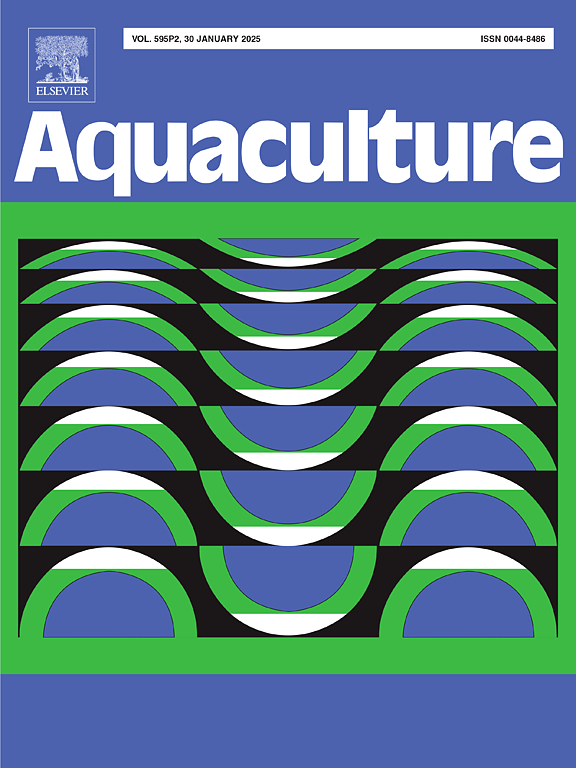Physiological, metabolic, and histological responses of juvenile Schizothorax grahami to acute nitrite stress
IF 3.9
1区 农林科学
Q1 FISHERIES
引用次数: 0
Abstract
Nitrite is a prevalent environmental stressor in aquaculture, adversely impacting fish health and survival. This study investigated the effects of acute nitrite exposure (0, 20, 40, 60, 80 mg/L for 96 h) on juvenile Schizothorax grahami, specifically assessing survival, histological alterations, biochemical parameters, and the expression of related genes and proteins. The 96-h LC50 was determined to be 42.3 mg/L, indicating a moderate sensitivity to nitrite. Histological analysis revealed dose-dependent gill damage, such as shortened filaments and epithelial oedema. Meanwhile, intestinal villi width and goblet cell density increased adaptively at moderate nitrite levels but exhibited mild disruption at higher concentrations. Blood analysis revealed elevated serum chloride levels at lower nitrite concentrations, indicating disrupted ionic homeostasis. Antioxidant activity (SOD) remained stable at lower nitrite concentrations but declined significantly at 80 mg/L, accompanied by a concurrent rise in malondialdehyde (MDA) levels, suggesting oxidative damage under high-concentration nitrite stress. Western blot analysis demonstrated upregulation of inflammatory cytokines (TNF-α, IL-1β) and the autophagy marker LC3b under high nitrite levels. Nitrite exposure altered hepatic glucose metabolism, characterized by increased g6pc and decreased gk expression. Lipid metabolism shifted toward oxidation (upregulation of pparaa and cebpa) and reduced biosynthesis (fas). These findings demonstrate that acute nitrite stress disrupts metabolic and physiological processes, underscoring the necessity of effective management strategies to mitigate nitrite toxicity in aquaculture.
幼鱼对急性亚硝酸盐应激的生理、代谢和组织学反应
亚硝酸盐是水产养殖中普遍存在的环境应激源,对鱼类健康和生存产生不利影响。本研究研究了急性亚硝酸盐暴露(0、20、40、60、80 mg/L,持续96 h)对格拉哈姆裂腹幼鱼的影响,特别是评估了存活率、组织学改变、生化参数以及相关基因和蛋白质的表达。测定96 h LC50为42.3 mg/L,对亚硝酸盐有中等敏感性。组织学分析显示剂量依赖性鳃损伤,如纤维缩短和上皮水肿。同时,在中等亚硝酸盐水平下,肠绒毛宽度和杯状细胞密度自适应增加,但在较高浓度下表现出轻度破坏。血液分析显示,在较低的亚硝酸盐浓度下,血清氯化物水平升高,表明离子稳态被破坏。抗氧化活性(SOD)在较低亚硝酸盐浓度下保持稳定,但在80 mg/L浓度下显著下降,同时丙二醛(MDA)水平升高,提示高浓度亚硝酸盐胁迫下的氧化损伤。Western blot分析显示,在高亚硝酸盐水平下,炎症因子(TNF-α, IL-1β)和自噬标志物LC3b上调。亚硝酸盐暴露改变了肝脏葡萄糖代谢,其特征是g6pc升高和gk表达降低。脂质代谢转向氧化(pparaa和cebpa上调)和减少生物合成(fas)。这些研究结果表明,急性亚硝酸盐应激会破坏代谢和生理过程,强调需要有效的管理策略来减轻水产养殖中的亚硝酸盐毒性。
本文章由计算机程序翻译,如有差异,请以英文原文为准。
求助全文
约1分钟内获得全文
求助全文
来源期刊

Aquaculture
农林科学-海洋与淡水生物学
CiteScore
8.60
自引率
17.80%
发文量
1246
审稿时长
56 days
期刊介绍:
Aquaculture is an international journal for the exploration, improvement and management of all freshwater and marine food resources. It publishes novel and innovative research of world-wide interest on farming of aquatic organisms, which includes finfish, mollusks, crustaceans and aquatic plants for human consumption. Research on ornamentals is not a focus of the Journal. Aquaculture only publishes papers with a clear relevance to improving aquaculture practices or a potential application.
 求助内容:
求助内容: 应助结果提醒方式:
应助结果提醒方式:


